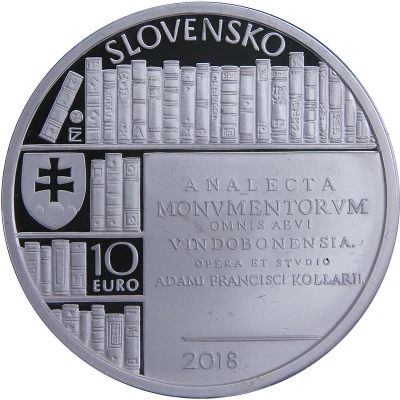


10 Euros Slavonic Liturgical Language
2018 year| Silver (.900) | 18 g | 34 mm |
| Issuer | Slovakia |
|---|---|
| Period | Republic (1993-date) |
| Type | Non-circulating coin |
| Year | 2018 |
| Value | 10 Euros 10 EUR = USD 11 |
| Currency | Euro (2009-date) |
| Composition | Silver (.900) |
| Weight | 18 g |
| Diameter | 34 mm |
| Shape | Round |
| Technique | Milled |
| Orientation | Medal alignment ↑↑ |
| Updated | 2024-10-07 |
| Numista | N#135210 |
|---|---|
| Rarity index | 78% |
Reverse
The reverse depicts Cyril and Methodius below the arms of a crucifix. These elements are set against a circle in which Glagolitic letters are interspersed. In semi-circle along the edge of the design, from the lower left to the lower right, is the inscription ‘UZNANIE SLOVANSKÉHO LITURGICKÉHO JAZYKA’ (‘Recognition of the Slavonic liturgical language’). The year ‘868’ appears at the bottom, below the crucifix.
Scripts: Glagolitic, Latin
Lettering:
UZNANIE SLOVANSKÉHO LITURGICKÉHO JAZYKA
868
Engraver: Dalibor Schmidt
Edge
Smooth with inscriptions in hollow.
Script: Latin
Lettering: • Konštantín a Metod • pápež Hadrián II. • Rím
Translation: • Constantine and Methodius • Pope Adrian II • Rome
Comment
Designer: Roman LugárThe arrival of the Thessalonian brothers Constantine (later Cyril) and Methodius to Great Moravia in 863 is among the most significant events in Slovak history. The two missionaries understood that a nation's stature was determined by its culture and education. Hence in their missionary activity they taught and wrote in the vernacular Slavonic and translated the scriptures and liturgy into the language. In 867, at the invitation of Pope Nicholas I, they went to Rome to seek the establishment of an independent ecclesiastical province in Great Moravia. En route they stopped at Venice, where Constantine defended the Slavonic liturgy before high-ranking clergy who insisted that only Latin, Greek and Hebrew could be liturgical languages. After arriving in Rome the two brothers were received by Pope Nicholas's successor, Pope Adrian II, who in February or March 868 approved their Slavonic versions of the liturgy and scripture and ordained Methodius and several of his and Constantine’s seminarians as priests and deacons. The pope's approval of the Slavonic liturgy and scripture represented the ultimate recognition that the brothers' work could have received in the then Christian Europe.
Interesting fact
One interesting fact about this coin is that it features an image of St. Cyril, a Byzantine monk and missionary who, along with his brother Methodius, is credited with creating the Glagolitic alphabet, which was used to translate the Bible and other religious texts into Old Church Slavonic, an ancient Slavic language. The coin's design honors the 1150th anniversary of St. Cyril's death and highlights the significance of his contributions to Slavic culture and Christianity.
Price
| Date | Mintage | VG | F | VF | XF | AU | UNC |
|---|---|---|---|---|---|---|---|
| 2018 | 5900 | - | - | - | - | - | - |
Values in the table are based on evaluations by sales realized on Internet platforms. They serve as an indication only for 10 Euros (Slavonic Liturgical Language) 2018 coin.



